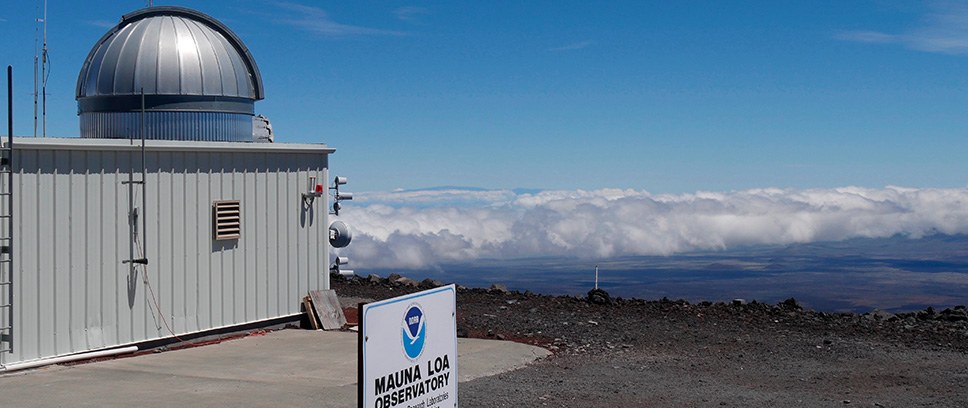
The History of the Climate Crisis: open or inevitable?
Christian Pfister | 22. April 2024
To mark Earth Day, we publish the following article by historian Christian Pfister, which first appeared in the booklet accompanying the exhibition “Roads not Taken. Or: Things could have turned out differently”.
First a few thoughts on the openness of history in the matter of the climate crisis. History is above all open-ended when it has to do with human action or non-action. Caesura in political history are oriented on events that make a big splash and lay the groundwork for the future, such as the emergence of the German Empire, the two world wars, or the fall of the Berlin Wall. By contrast, the climate history of the past 170 years is based on the gradual change of the material-energetic structure of the atmosphere through the use of fossil-fuel energy sources. This change follows a causality based on natural law.
For most people, the gradual transformation of the worldwide climate long remained barely perceptible and could therefore hardly be recognised as a historical turning point. Once initiated, it follows the laws of nature which at first glance are not subject to historical randomness in the sense of contingency. The melting of the polar ice, for example, will hardly be influenced by the outcome of a battle or the actions of individual politicians. Before this backdrop, counterfactual mind games about how climate history could have taken a different turn seem to be almost obsolete. Nevertheless, a certain open-endedness of history can also be perceived here – namely in the building of consciousness for the dangers of this development. If, despite the above-mentioned factors, you would want to venture into such counterfactual thought experiments, you would have to ask yourself at what point in environmental history could alternative developments have broken new ground. A prerequisite for this undertaking is that you need a precise knowledge of what constitutes environmental history.
A history of the environment was first unlocked in the past few decades. Due to a growing consciousness of the mutual interdependencies between mankind and the environment, environmental history now stands on the same tier as political history, economic history or cultural history. Among other things, it needs to work out where the epochal threshold that forms the basis of the current climate crisis is to be fixed and what driving forces have caused the principal changes.

Epochs on the way to the climate crisis
A vast solar energy system forms the earth’s biosphere. Green plants convert a small part of the beamed-in solar energy into biomass. Before the era of industrialisation, biomass in the form of foodstuffs, fodder for livestock as well as wood providing warmth was the most important source of energy. Mechanical rotation was generated by means of water or windmills or through animal power. All residual products were biodegradable. The available energy per capita was ten times lower than today, but it was unlimitedly renewable. People were subject to crop failures and acts of nature, but they had developed a corresponding awareness of such risks.
By exploiting the fossilised solar energy stored for millions of years in the earth’s interior, a growth-orientated economic system was developed that could feed a larger world population and bring prosperity to many people, especially in the northern regions. The fact that this development caused a minor change in the composition of the atmosphere from year to year first became perceptible when the utilisation of fossil-fuel energy sources had grown by an inconceivable degree.
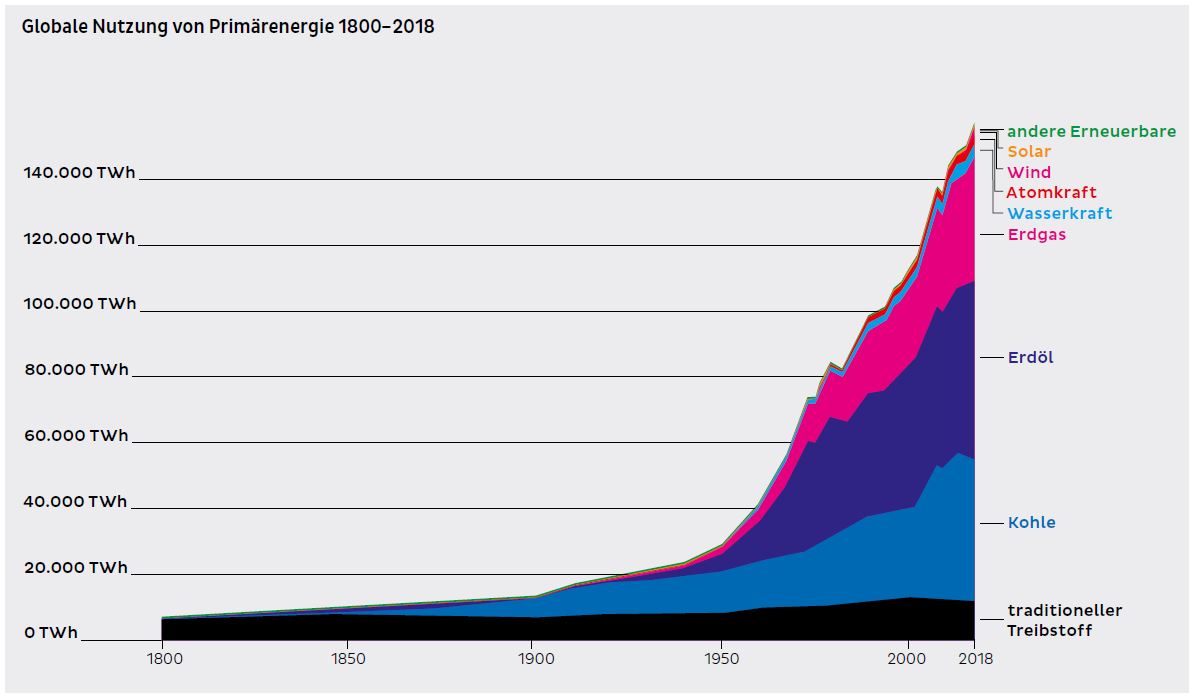
Anyone who asks about the cause of the current climate crisis first gets pointed to the beginning of industrialisation in the 19th century. In principle, this notion is correct. But as the chart pictured here illustrates, it is not enough to explain the magnitude and dynamic of the development. Three different periods can be accounted for. Until around 1850 only biomass was used, the amount of which has hardly changed since then. With intensive coal mining, Germany entered the circle of industrial nations in the 1850s. Underground mining was labour-intensive and expensive. It was worthwhile to develop energy-saving technologies and to economise on coal. From the late 1950s to the present, the use of fossil-fuel energy sources increased about sixfold. Around a billion tons of crude oil were produced between 1861 and 2018, 97 percent of which was after 1957, as well as huge amounts of coal and natural gas. This fundamental course in the relation of Man to the environment which was established in the 1950s is known as the “1950s Syndrome”.
The collapse of energy prices
This collapse began with the exploitation of the seemingly inexhaustible oil reserves in the Middle East. Until the early 20th century, natural oil in the form of lamp oil played an insignificant role as a light source in the rural world before the lightbulb took the place of the petroleum lamp. On the eve of the First World War, oil gained strategic importance as fuel for British warships. In the interwar years the advancing motorisation provided a rapidly growing market for petroleum, above all in the USA. In 1933, Standard Oil of California concluded a contract with the Saudi King Ibn Saud, in which he conceded to Standard Oil the mining and excavation rights for oil in Saudi Arabia for the next 60 years on an area of 500,000 km², which corresponds to one-and-a-half times the size of the Federal Republic of Germany. During the Second World War a battery of hundreds of American specialists set about boring for oil in the Saudi deserts. The results exceeded their wildest expectations. A member of the team placed on record that oil in this region was the greatest treasure in the history of mankind.
From the 1950s on, Mideastern oil flooded the markets. In many oil producing countries it flowed like water out of the boreholes. At first the oil companies kept the oil price high, which brought them fabulous profits. From 1957 onwards the prices began to fall. By 1970 they had reached one fifth of the cost in 1950. Cheap oil flushed away the expensive coal from world markets, unless, as in Germany, measures were undertaken to peg the price.
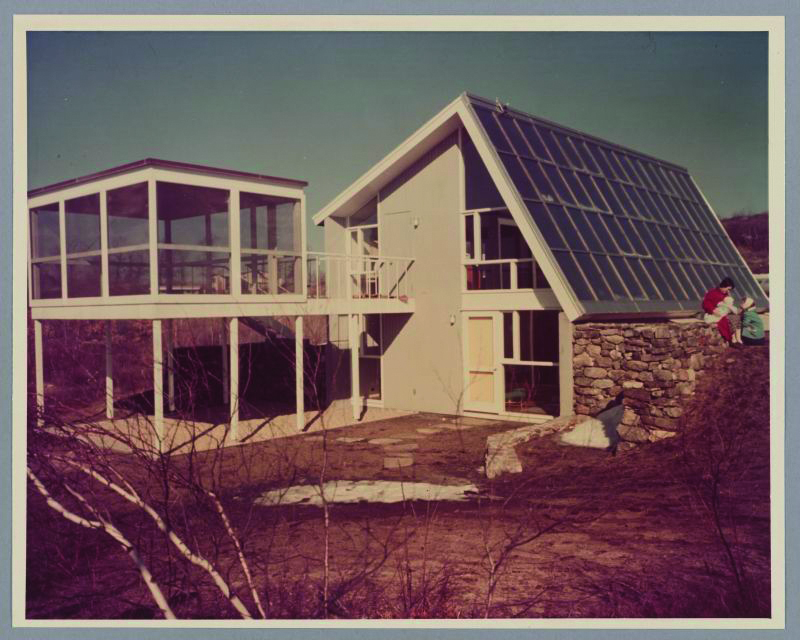
Cheap energy as a growth accelerator
The collapse of the energy prices turned the global economy upside down. The period between 1950 and 1973, the time of the German economic miracle, inaugurated an acceleration in global economic growth unique in history. Research has pointed out a variety of causes: population growth, more rational production methods such as the assembly line, greater international cooperation under the influence of the Cold War, seed capital provided to Western Europe by the USA through the Marshall Plan, and the amelioration of social antagonisms through the newly introduced spread of wealth in the welfare state. The price reduction of energy sources was barely taken into account because it was not very noticeable in everyday life.
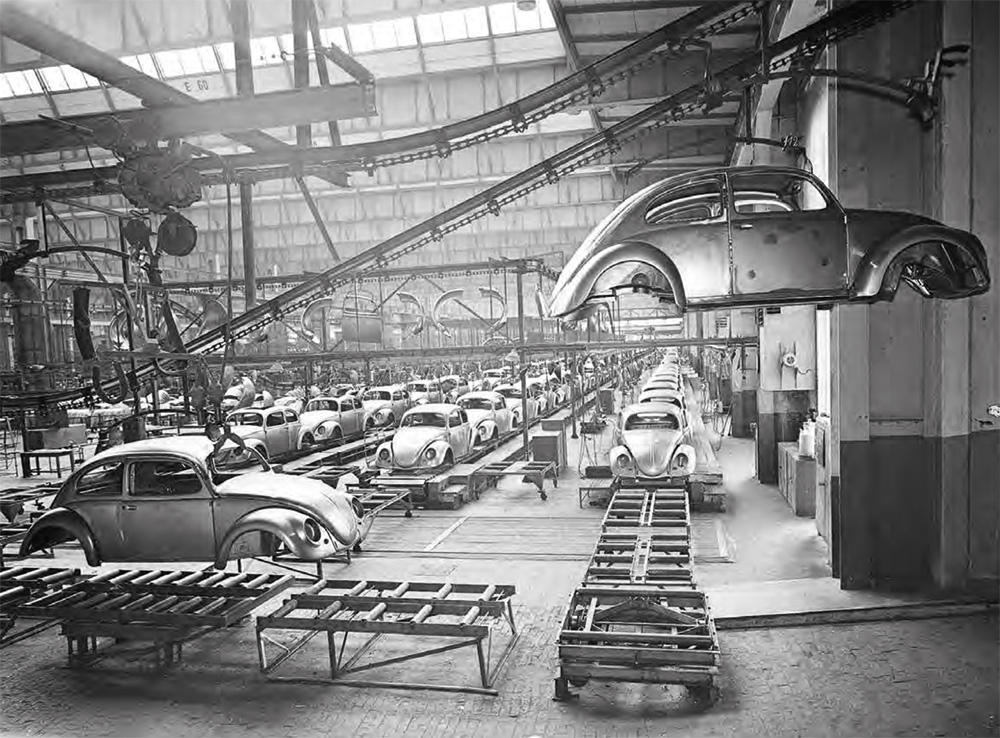
The demand for a particular product is not only influenced by its price, but also through price variations in other products. During the boom, labour became scarce, which caused wages to rise massively. It was only logical to employ more fossil-fuel energy to economise on labour costs, for example by shifting work processes to cheap labour countries despite the increased transport costs. In agriculture the massive employment of cheap fertiliser and imported fodder for intensive livestock farming contributed to substantial gains in productivity. This allowed food prices to be reduced, which freed up buying power. The fact that rapidly rising energy and food prices puts a burden on our budget is an everyday experience for all of us. It stands to reason that the opposite process – the massive reduction in energy costs from the late 1950s onward – stimulated the economy and fuelled consumption. Even without cheap energy there probably would have been considerable growth in the post-war period, but no doubt in a less lavish way.
If you wanted to chart a counterfactual course of history to that of the wasteful use of fossil fuel since the beginning of the 1950s, you would first have to search for a historically plausible event that could have fundamentally changed the general political, economic and social conditions in the post-war period.
The emergence of the consumer society
A glance at the living conditions in the turbulent post-war years in Germany and elsewhere in Europe shows how profoundly everyday life changed after the 1950s. Most households could only afford food, clothing, and a few special extras. In 1950 a skilled worker had to work for five hours to buy ten litres of petrol, which helps to explain why there were so many small cars occupying the streets. Flights were prohibitively expensive.
Cultural critic Vance Packard spotted the signs of the new era early on. “Man throughout recorded history has struggled—often against appalling odds—to cope with material scarcity,” he wrote in his book The Waste Makers (1960, p. 10). Today, the great challenge “is to cope with a threatened overabundance of the staples and amenities and frills of life. Historians, I suspect, may allude to this as the Throwaway Age.” The long period of growth entailed an increased amount of consumer stimulation that fundamentally changed everyday life. It played a direct role in several so-called revolutions: mass motorisation with a preference for increasingly large automobiles, urban sprawl, construction of shopping malls in the countryside, and record-breaking low prices for air travel, luring people to book cheap holidays abroad.
Energy-saving technologies such as solar energy, that for the most part were still in their infancy, were abandoned in the 1980s – in fact, already in 1958 a solar house had been built in the USA which could get half of the heating needed in wintertime through solar energy. Forty years of solar research were wasted in this way.
With regard to a counterfactual construct of environmental history in reference to the present climate crisis, a further approach could be to seek out credible moments of decision-making in political and economic history when the development and use of energy-saving technologies worldwide could have gained the upper hand. An example of such a moment is found in the term of office of the Democratic president Jimmy Carter. Since taking office in 1977 he promoted the use and development of solar energy – a development that came to an abrupt halt in 1981 when he failed to be re-elected.
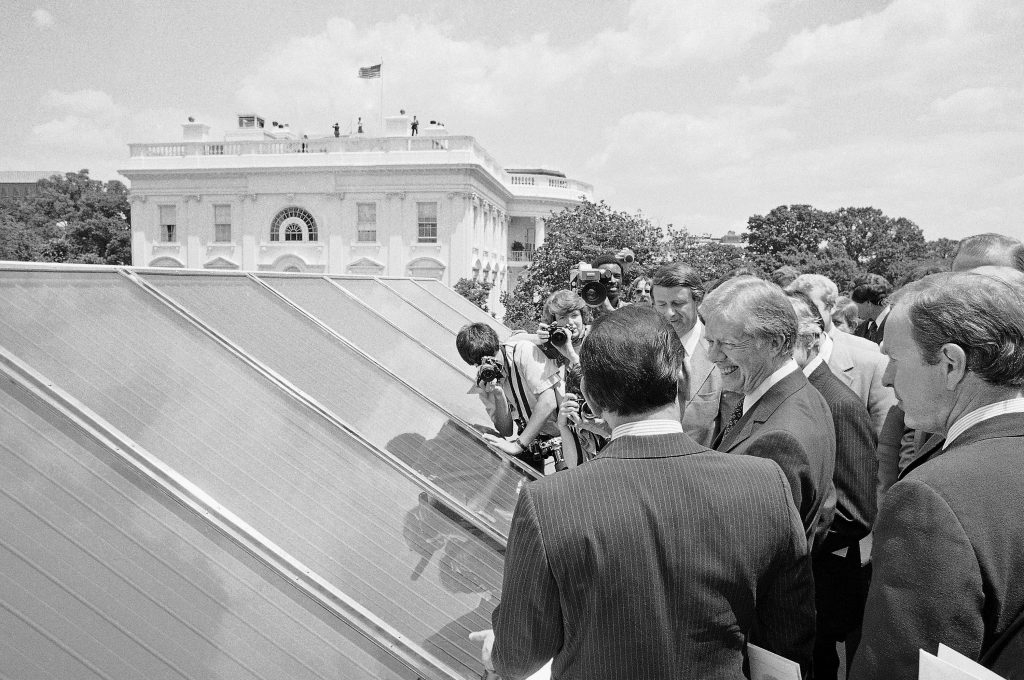
From gentle to threatening climate change
Around 1900, the Swedish Nobel Prize laureate Svante Arrhenius concluded that the increased combustion of coal was causing the temperature of the atmosphere to rise. A doubling of CO2, he calculated, would raise the temperature of the earth by about 5 or 6 degrees centigrade, but thousands of years would pass before this happened. His supposition was supported by a hitherto barely known phenomenon.
Solar radiation in the northern hemisphere declined very slowly since the end of the last Ice Age as a result of periodic changes in the earth’s rotation around the sun. Therefore it became increasingly colder until the early 19th century. In the region of the Alps the cooling became apparent in the extensive forward thrust of glaciers between the 14th and 19th centuries, known as the “Little Ice Age”. The gradual rise in temperature due to coal-fuelled industrialisation counteracted the cooling tendency caused by the solar rotation. It found expression for many decades in the decrease in cold temperature extremes, which brought an end to the “Little Ice Age”.
The boost in the use of fossil-fuel energy sources resulting from the oil glut since the late 1950s is unique in human history. It brought about a historically singular rapid increase in greenhouse gas emissions (see the accompanying chart). Thus, mankind became a geological force.
At exactly the time of the oil glut starting in the year 1958, the CO2 concentration in the atmosphere began to be measured continuously at the Mauna Loa volcano in Hawaii. This was a fortuitous accident.
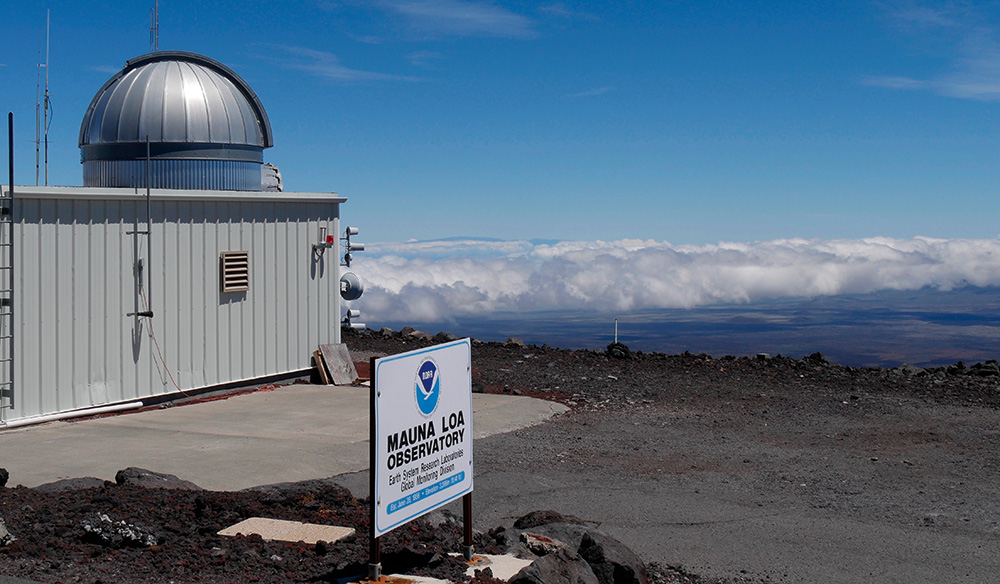
The concurrence of the beginning of measurements on Mauna Loa with the unchecked consumption of fossil-fuel energies can be seen as a moment of historical contingency. Without these measurements a consciousness of the dangers of the human influence on the climate probably would have come much later. In what ways the scientific evidence of these measurements might have sensitised humankind more quickly to the dangers of our wasteful consumption of energy remains open to discussion.
The global temperature first reacted to the rapid increase in CO2 concentration in 1989 – i.e., with a 30 year delay – with a huge leap to a higher level. This was greater than in the last 2000 years and for the first time comprised all seasons.
The sluggish reaction of the climate system has delayed the solution of the problem. Physicists and climatologists have followed the “fever curve” of greenhouse gases with growing concern from early on. Already in 1981 the German climatologist Hermann Flohn wrote in the scientific journal Physikalische Blätter, “The fate of our children and grandchildren in the entire world is at stake.” But as long as the general population cannot feel the threat first hand, politics lacks the necessary backing to implement stringent measures. From the 1990s on, the climate issue got dragged down into the bickering of national and international politics, whereby the enemies of sustainable measures stop(ped) at nothing to discredit climate science.
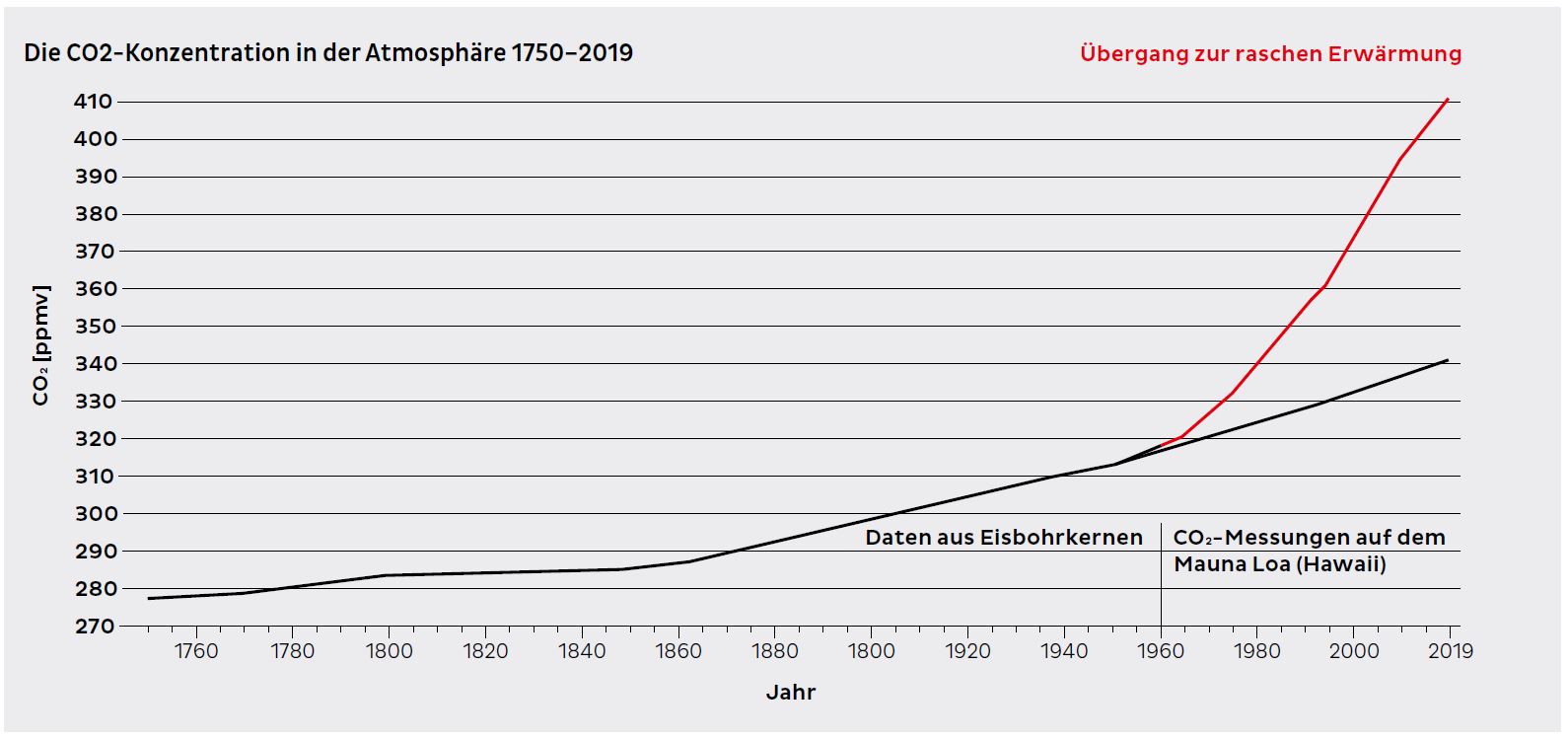
Conclusion
From the late 1950s on, the Mideastern oil glut overflooded the world market. Cheap energy paved the way for a profligate dealing with life and the economy. Today we have to pay for these effects on the climate. A significant economic growth during the post-war boom years would have been possible, but in a less wasteful form. Such a development would have given us more time to solve the climate crisis. The same is true of a quicker shifting to alternative energy sources from the 1990s on, without the long and ineffectual confrontation with the climate deniers.
The missed chances, such as the greater use of renewable energy sources and the early implementation of climate protection measures, can hardly be calculated in their repercussions for the open-endedness of human history. The lack of time severely restricts our potential scope of action. Nevertheless, history, and thus the future of humanity as well, remains open to accidental occurrences and above all to the determinative factors of human action.
Sources
Hermann Flohn: Klimaänderung als Folge der CO2-Zunahme? In: Physikalische Blätter 37 (1981), 7, pp. 184–190.
Angus Maddison: Contours of the World Economy. 1–2030 AD. Oxford 2007.
Raphael Neukom et al.: No evidence for globally coherent warm and cold periods over the preindustrial Common Era. In: Nature 571 (2019), 7766, pp. 550–554.
Vance Packard: The Waste Makers. New York 1960.
Christian Pfister und Heinz Wanner: Klima und Gesellschaft in Europa. Die letzten tausend Jahre. Bern 2021.
Christian Pfister: Das 1950er Syndrom. Die umweltgeschichtliche Epochenschwelle zwischen Industriegesellschaft und Konsumgesellschaft. In: Christian Pfister (ed.): Das 1950er Syndrom. Der Weg in die Konsumgesellschaft. Bern 1995, pp. 51–97.
Vaclav Smil: Energy Transitions. Global and National Perspectives. Santa Barbara 2017.
Daniel Yergin: The Prize. The Epic Quest for Oil, Money & Power. New York 2008.
Under primary energy we understand the raw energy materials that occur in nature, such as wood or crude oil, as well as natural energy sources before they have been converted into end energy, like electricity or petrol.
Energy is the central force that drives processes in the material world. The concept, which comes from physics, was taken into everyday speech in the 19th century. It is understood in the sense of energy services such as food, heat, transport, communication and mechanical labour.
The medicinal term syndrome refers in the figurative sense to the interaction of occurrences that are based on a phenomenon.
Christian PfisterChristian Pfister is professor emeritus at the University of Bern, Switzerland. He is considered a co-founder of the historical climatology branch of environmental and climate history, which combines historical research with natural science. Today he works at the Oeschger Centre for Climate Research (OCCR). In this article he gives an overview of the causes, the course, and the decisive moments of the global climate crisis.. |